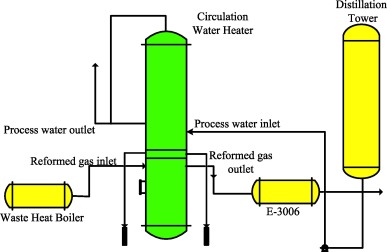The photo shows a big HP (2500psi (17MPa) on both sides) exchanger bundle. There are four drilled and tapped holes in the tubesheet for fitting eye-bolts to pull the bundle, which weighed almost 11 tons. (Be grateful that this isn’t a TV script, I would be honour bound to have given that weight in Cockroaches or Thomson’s Gazelles or some such.) Cracks ran from these to adjacent tube holes, as can be seen in the insert, bottom right. The insert photo was taken after the tube had been extracted. None of the tubes, nor tube seal welds, were cracked.
Investigation showed that this was Chloride SCC. We had established, before the turn-around, that, while chlorides could be present, this was unlikely, and, even if present, it was unlikely to be a concern under process conditions.
The eye-bolt holes had been sealed off with short screwed plugs that had been seal welded after installation. Why they were welded is unclear: removing the plugs necessitated grinding off the weld, as can be seen in the photo. The plugs had no head, and were only a fraction the length of the bolt holes, so could not be tightened – but a tack-weld would have held them in place.
We concluded the source of chloride, if not from the process, may have been from residual town water, trapped in the bolt-holes after the manufacturer’s pressure test. This seems to be the most logical explanation, particularly in view of the fact that there was no cracking anywhere else.
This implies seal welding the plugs was done after the hydrotest.
We could not follow up with the manufacturer as it was overseas, and no longer in business.
As a short term fix to get back on line, the plugs were redesigned with a hex head and an annular lip so it could seal against the tubesheet with a gasket. The tube hole was plugged in some fashion – I forget the details. It was essential that the exchanger did not leak from tube- to shell-side.
An obvious problem was that the eye-bolt holes had been drilled so close to the tube-holes. The design drawings showed the centre locations of tube holes and eye-bolt holes marked by + signs only, with no indication that the designer had worked out how close the OD’s came. It is surprising that the fabrication shop proceeded without questioning it – one wonders if they would have done so if the holes had actually overlapped! It would be even more alarming to find that this had been questioned and approved–.
The permanent solution was to install a new bundle at a cost of about $250,000 – and this about 15 years ago. The eye-bolt holes were moved a considerable distance from the tubes – as is obvious, there was plenty of suitable real-estate for them!
The lessons are fairly obvious: –
Close check on design, and beware the +’s – work out what they actually imply
Assure hydrotest is performed with a suitable medium
Small details can cost a lot of cash!


